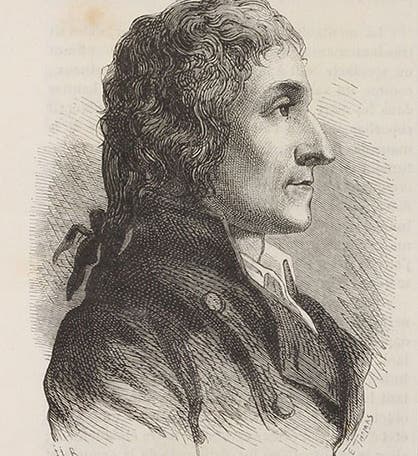Scientist of the Day - Joseph Proust
Joseph Louis Proust, a French chemist working in Spain, was born Sep. 26, 1754. In 1794, Proust published a paper, "Researches on Prussian blue," in which he first set down the law of definite proportions, or Proust's law, as it is commonly known. Before Proust, it was generally thought that two elements could combine in any number of ways, so that if you were making iron sulfide, and you had a lot of iron, you might produce an iron-rich sulfide, whereas if iron were in short supply, the compound would have more sulfur. There could, it was thought, be a whole range of iron sulfides.
Proust showed that iron could combine with sulfur, or with oxygen, in only two ways, each time with definite and repeatable proportions, and that there were no in-between compounds. Proust's law was mildly controversial until 1808, when John Dalton argued that iron and sulfur consist of atoms of different weights. In a compound of one atom of iron and one atom of sulfur, the ratio of iron to sulfur would always be the same, being the ratio of the weight of an atom of iron to the weight of an atom of sulfur. The proportions would have to be constant. An atom of iron can also combine with two atoms of sulfur, but again, the proportions for iron disulfide would also be definite and constant. Dalton’s atomic theory of the elements was not immediately embraced. But after 1812, Proust’s law can to be accepted by most chemists as an empirical reality, whatever their position on atoms.
Proust's article on Prussian Blue was published in the Journal de Physique for 1794; we see here the opening pages of the article, and a detail of the last. The final paragraph says: "I conclude from these experiments with the principle that I set down at the beginning of this memoir: that iron is, like several other metals, subject by that law of nature that presides over all true combinations, to two constant proportions of oxygen. It does not differ in this respect from tin, mercury, lead, and from nearly all the known combustible materials."
One might have thought they would have named iron ferrocyanide after Proust, since that is what constitutes Prussian blue. Instead, Proust is commemorated by a lovely little semi-precious mineral, proustite. Unfortunately, it is a bauble for the boudoir only, for it tends to turn black if you take it out into the sun.
The portrait of Proust (first image) may be found in the second volume of Louis Figuier’s Les merveilles de la science (1867).
Dr. William B. Ashworth, Jr., Consultant for the History of Science, Linda Hall Library and Associate Professor, Department of History, University of Missouri-Kansas City. Comments or corrections are welcome; please direct to ashworthw@umkc.edu.









